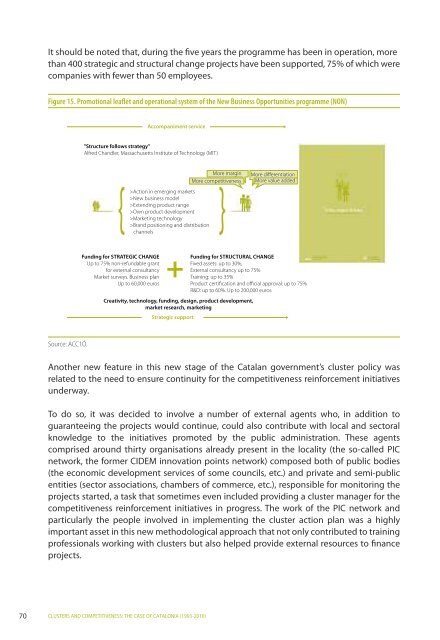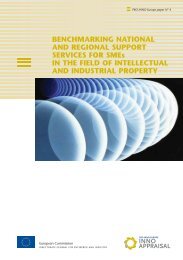Clusters and competitiveness - PRO INNO Europe
Clusters and competitiveness - PRO INNO Europe
Clusters and competitiveness - PRO INNO Europe
You also want an ePaper? Increase the reach of your titles
YUMPU automatically turns print PDFs into web optimized ePapers that Google loves.
It should be noted that, during the five years the programme has been in operation, more<br />
than 400 strategic <strong>and</strong> structural change projects have been supported, 75% of which were<br />
companies with fewer than 50 employees.<br />
Figure 15. Promotional leaflet <strong>and</strong> operational system of the New Business Opportunities programme (NON)<br />
Source: ACC1Ó.<br />
Accompaniment service<br />
"Structure follows strategy"<br />
Alfred Ch<strong>and</strong>ler, Massachusetts Institute of Technology (MIT)<br />
Funding for STRATEGIC CHANGE<br />
Up to 75% non-refundable grant<br />
for external consultancy<br />
Market surveys. Business plan<br />
Up to 60,000 euros<br />
>Action in emerging markets<br />
>New business model<br />
>Extending product range<br />
>Own product development<br />
>Marketing technology<br />
>Br<strong>and</strong> positioning <strong>and</strong> distribution<br />
channels<br />
+<br />
Creativity, technology, funding, design, product development,<br />
market research, marketing<br />
Strategic support<br />
70 CLUSTERS AND COMPETITIVENESS: THE CASE OF CATALONIA (1993-2010)<br />
More margin More differentiation<br />
More <strong>competitiveness</strong> More value added<br />
Funding for STRUCTURAL CHANGE<br />
Fixed assets: up to 30%,<br />
External consultancy up to 75%<br />
Training: up to 35%<br />
Product certification <strong>and</strong> official approval: up to 75%<br />
R&D: up to 60%. Up to 200,000 euros<br />
Another new feature in this new stage of the Catalan government’s cluster policy was<br />
related to the need to ensure continuity for the <strong>competitiveness</strong> reinforcement initiatives<br />
underway.<br />
To do so, it was decided to involve a number of external agents who, in addition to<br />
guaranteeing the projects would continue, could also contribute with local <strong>and</strong> sectoral<br />
knowledge to the initiatives promoted by the public administration. These agents<br />
comprised around thirty organisations already present in the locality (the so-called PIC<br />
network, the former CIDEM innovation points network) composed both of public bodies<br />
(the economic development services of some councils, etc.) <strong>and</strong> private <strong>and</strong> semi-public<br />
entities (sector associations, chambers of commerce, etc.), responsible for monitoring the<br />
projects started, a task that sometimes even included providing a cluster manager for the<br />
<strong>competitiveness</strong> reinforcement initiatives in progress. The work of the PIC network <strong>and</strong><br />
particularly the people involved in implementing the cluster action plan was a highly<br />
important asset in this new methodological approach that not only contributed to training<br />
professionals working with clusters but also helped provide external resources to finance<br />
projects.
















